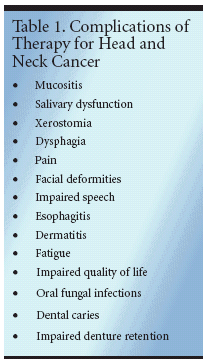Dental Consult/Cytoprotection Strategies in Management of Oral Effects of RT for Head and Neck Ca
The 14 reports in this special supplement discuss theuse of the cytoprotectant amifostine in patients withcancer of the head and neck, esophagus, lung, andcervix, as well as those with lymphoma and acutemyelogenous leukemia. Discussions focus on thepotential of this agent to both reduce radiation sideeffects such as xerostomia and permit doseescalation of chemotherapy and/or radiotherapy.Improvements in treatment outcome and quality oflife as a result of cytoprotection are examined.
NEW YORK-Externalbeamradiotherapy (EBRT) causesirreversible salivary dysfunction inmany patients treated for head andneck cancer. One strategy for reducingtreatment-associated morbidityis to get a dental consult toprepare the patient before beginningchemoradiotherapy. Anotherstrategy, now in clinical trials, isto add cytoprotection with amifostine(Ethyol) to the treatmentregimen. Both approaches werediscussed by Jonathan A. Ship,DMD, professor, Department ofOral Medicine, and director, BluestoneCenter for Clinical Research,NYU College of Dentistry.Oral Effects of Tx Significant
"Head and neck cancers causemore deaths annually than malignantmelanoma, Hodgkin's disease,and cervical cancer," Dr. Shipsaid. "Survival rates are poor, withonly 50% of patients living 5 yearsafter diagnosis, and all treatmentshave adverse sequelae. The severedental and oral effects are oftenneglected in the rush to multimodalitytherapy" (see Table 1).Mucositis can be dose-limitingand volume-limiting in combinedchemoradiotherapy programs,Dr. Ship said.He also noted that mucositis isa portal of entry for oral microorganisms,leading to potentiallylife-threatening secondary localand systemic infections.

Dental Consult Recommended
"Patients need to see a dentistprior to head-neck radiotherapy.Radiotherapy-induced mucositisdevelops 7 to 10 days after treatmentinitiation," he said.He added that there is an incorrectbut widespread assumptionthat dental care would not be reimbursedby Medicare. "Certainprocedures in preparing the mouthprior to head-neck radiotherapyare covered by Medicare. This candecrease pain and improve qualityof life."Serous salivary glands such asthe parotid, he explained, are highlyradiosensitive, and serous cellsare destroyed within 1 to 6 hoursafter irradiation with single dosesas low as 200 cGy. Noting that cancertreatment doses are beingpushed to 65 to 70 Gy, he said adose of only 25 to 30 Gy can permanentlydestroy major salivaryglands."The radiation sequela of salivarydysfunction remains a bothersomeproblem for patients whohave received EBRT," Dr. Ship said."Long-term salivary hypofunctioncauses new and recurring dentalcaries; fungal infections; difficultiesin chewing, tasting, and swallowing;and impaired retention ofdentures, and further, oral-facialpain, nutritional compromise, andimpaired communication impairquality of life for many years."High-Density Radiotherapy Plus Amifostine
Dr. Ship described a clinicalinvestigation of combined high-dose rate intraoperative radiotherapy(HD-IORT), EBRT, and amifostine.He has partnered with Dr.Kenneth Hu at Beth Israel MedicalCenter, New York, for this innovativeapproach. The protocol includedsurgery to the primary siteand the neck, with intraoperativedelivery of 12 to 15 Gy to the site oftumor (brachytherapy), postoperativeEBRT (50 to 60 Gy), and concomitantuse of amifostine (SC 1hour prior to RT). He said thatHD-IORT dose escalation providesimproved locoregional control,shortens total treatment duration,and decreases toxicity byreducing the EBRT dose. Applicatorsare made of flexible siliconthat can be tailored to fit easily intothe tumor bed.The study hypothesis is that thecombination of HD-IORT andEBRT with a cytoprotectant (amifostine)will reduce radiationinducedmucositis and xerostomiain head and neck cancer patients.Inclusion criteria include oral cavityoropharynx, larynx, and hypopharynxsquamous cell carcinomawith spread to regionallymphatics, with surgery of boththe primary site and neck, no evidenceof distant metastases, andno previous radiotherapy or chemotherapy.Multiple Assessments
Quality of life and performanceassessments include ECOG (EasternCooperative Oncology Group)Performance Status, RTOG (RadiationTherapy Oncology Group)Late Radiation Morbidity ScoringScheme, RTOG Pharynx andEsophagus Toxicity Grading,FACT (Functional Assessment ofCancer Therapy) Head and Neck,the Terrell Head and Neck Qualityof Life Instrument, and the ListPerformance Status Survey.Salivary function and xerostomiaare assessed using the XerostomiaScore, Xerostomia Questionnaire,Xerostomia Quality ofLife Questionnaire, and salivarycollection (both unstimulated andstimulated whole saliva). Mucositisand pharyngitis assessment includethe WHO (World HealthOrganization) Mucositis Grade,CTC (Common Toxicology Criteria)v. 2 Mucositis Grade, CTC v. 2Pharyngitis Grade, CTC v. 2 DermatitisGrade, and CTC v. 2 DysphagiaGrade.Two Patients Enrolled
Dr. Ship said that so far, thestudy includes one 50-year-oldmale enrolled with 9-month post-RT data and one 61-year-old malewho just completed RT. The 50-year-old patient who has completedRT had a moderately differentiatedsquamous cell carcinoma ofthe right neck (stage IV, N2b M0).He underwent surgical removal ofthe tumor with unilateral neck dissectionand was then treated with12 Gy of HD-IORT, 50 Gy of EBRT,and 500 mg SC amifostine daily."There were no significant adverseevents and no treatment interruptions,"Dr. Ship said.The 50-year-old patient who hascompleted treatment had mild mucositiswith erythema of the mucosaduring the second to sixthweek of EBRT. "The score returnedto baseline (grade 0) at allpost-EBRT visits," Dr. Ship reported.Similarly, mucositis, pharyngitis,and dysphagia were grade 0 or1 during EBRT and all returned tograde 0 at 1 month post-EBRT.Fatigue and radiation dermatitiswere grade 0 or 1 during RT andreturned to grade 0 at 1 monthpost-EBRT.Better Salivary Function, QOL
"At the completion of EBRTthere was an approximately 80%decrease in both unstimulated andstimulated whole salivary flowrates. There was persistent salivaryhypofunction at 9 months post-EBRT, with slight recovery of stimulatedflow rates to 65% of pretreatmentfunction. The patienthad persistent xerstomia (RTOGLate Radiation Morbidity, grade2), from treatment until 6 monthspost-EBRT; it improved to grade 1at 9 months post-EBRT. The XerostomiaScore decreased to 1 at 9months post-EBRT," Dr. Ship said.Quality of life scores were striking.The patient had "nearly perfect"scores at 1, 3, 6, and 9 monthspost-EBRT for Head and NeckQOL Scale, FACT Head and NeckScale, List Performance StatusSurvey, and Xerostomia Qualityof Life Scale."HD-IORT and amifostine werewell tolerated and may reducetreatment-induced oral mucositis.This combination therapeutic approachdid not produce short-termsalivary preservation, but therewere few xerostomia-related quality-of-life problems," Dr. Ship said."Despite the dramatic losses inwhole unstimulated and stimulatedsaliva up to 9 months post-RT,complaints of xerostomia were few,and xerostomia-related quality-oflifeproblems were minimal. Thismay be due to preservation ofmucosal tissues during treatment,"he concluded.Dr. Ship cautioned that these resultsare very preliminary and basedon a very small sample size but areworthy of further research.